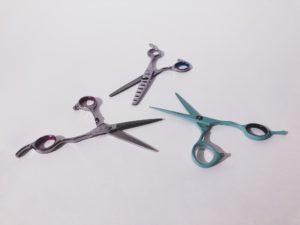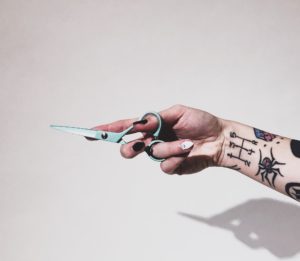How Frequently Should You Actually Get Your Haircut?

I know that this is a tough subject for some of you! How long has it been since you last got a haircut?
There actually isn’t an exact universal timeframe for everyone. Everyone’s hair is different and there is not one correct answer that I can give you. But I can tell you that you probably should be getting a haircut more frequently than you currently are.
I often cringe when I ask new clients how long it’s been since they’ve had their hair cut and their response is ” I haven’t had my hair cut in 9 months because I want to grow it out”.
Trust me when I say, that is NOT the way to grow long and healthy hair.
Why do I need a haircut?
First, we need to address that there are a number of reasons why one would need a haircut.
You may need to trim the split ends to keep them healthy, texturize the hair so that it lays properly, thin it out to remove bulk and weight, or shorten it to have a certain style and shape maintained.
Typically on average I suggest getting your hair cut every 4-8 weeks. But some clients come in as frequently as 2 weeks, and the longest I would ever push it is 3 months.
1. To trim your split ends
If you have split ends, listen to your stylist when they tell you how much needs to come off.
It may be shocking at first if they say a number of inches, but PLEASE trust them; your hair will continue to break if you do not cut off all of the damaged and broken pieces.
If you have 4 inches of splitting hair at your ends, cutting off 2 inches will not help you at all. You might as well not even do it. In order to make your hair healthy and stop breaking, you need to cut off the full 4 inches of splitting hair.
If you don’t take the full 4 inches off, the hair will continue to split up your hair. And it’s not that we enjoy cutting your hair short. But having 4 inches of straggle at the bottom of your hair is not going to do you any good, I promise.
If you’d like to read more on how to maintain/grow long and healthy hair, read my post here.
2. To texturize the hair
Texturizing is an incredibly important part of the haircut. It is what distinguishes a low quality haircut from a high quality haircut.
If your hair is cut wet and not checked dry, then this is not a finished haircut. Hair lays differently when wet, and needs to be checked dry every single time.
Let alone being checked for evenness, texturizing is done best on dry hair. When the hair is dry, the stylist can see the weight-lines and is able to remove bulk from areas that need to be lighter.
This allows the hair to get movement and volume in all the right places.
The amount of time in-between cuts that texturizing should be done relies completely on your hair and the style that you are aiming to achieve.
3. To get your hair thinned out
Yes thinning the hair is different from texturizing! Thinning the hair means to remove significant weight and bulk from the hair. This is done much higher up than texturizing. Texturizing is typically done to the ends of the hair, but thinning is done much closer to the scalp.
Thinning is not necessary for everyone, but there are some people that can’t live without it.
I’ve had clients with so much hair that it was extremely difficult for them to style on their own. One of my clients in particular came in on a minimum of a 3 week basis to have her hair thinned out. If she didn’t, she would get extreme headaches and even have a hard time shampooing it at home.
4. To maintain the shape of your style
Whether you are getting a totally new haircut or maintaining the same style, you’ll need to have it cut to achieve the look you want.
Typically shorter cuts will need to come in more frequently to keep the same shape going, but again this can change depending on the hair and style.
When it comes to bobs, they often start to flip out when the hair grows too long on the neck. Bangs will also turn into face framing pieces if they aren’t maintained.
How long should I wait between haircuts?
As mentioned earlier, the time frame between haircuts varies from person to person. Below I’ve listed out all the factors that you need to consider when finding that sweet spot for you.
Write down the number of weeks from each category that you fit into to determine the average amount of time you should go between haircuts.
5 Key Factors That Determine How Often To Get Your Hair Cut
- Hair type
- Condition of the hair
- Length and style
- Pretend haircuts
- How fast your hair grows
***Since I’m sharing the hair products that I love to use with you guys, my posts may include affiliate links to these products. If you take action and purchase a product through clicking one of my links, I’ll make some commission money from it. This enables me to be able to continue giving you awesome hair tips, so thanks! ***
1. Hair Type
Hair types can be easy to get confused! You can have any combination of texture, density, and wave pattern. Just because you have fine hair does not mean that it is thin and vice-versa.
There are 4 categories that determine your hair type. Each one plays a role in how often you should get your hair cut.
To learn more about what texture, density, and wave pattern you have, visit my post on hair types here.
Hair color

Clients with dark hair do not typically need trimmed as frequently as blondes. If the hair is naturally blonde it doesn’t contain the innermost layer of the hair, the medulla, so therefore it is weaker than dark hair and more susceptible to damage and splitting.
Dark hair also doesn’t get damaged as easily in the sun like blonde hair does. The sun can literally burn your pale blonde hair just as easily as it can burn pale skin. The only difference is, hair doesn’t go back to normal in a few days with some aloe and shea butter.
If you have light hair, be sure to protect it from the sun and get hair trims frequently! You can find my favorite UV protectant for summertime here.
Blonde hair: Average of 4-6 weeks.
Dark hair: Average of 8-12 weeks.
Hair Density
Typically clients with thick hair need to come in for haircuts more frequently than clients with thin hair. This is because the hair needs texturized and thinned out or else their haircut can loose its shape. I’ve even seen clients get extreme headaches from having too much hair.
Someone with thin hair doesn’t have this problem and can usually wait longer before needing to come in.
Thin hair: Average of 8-12 weeks.
Thick hair: Average of 4-6 weeks.
Hair Texture
On the contrary, fine hair typically needs cut more frequently than coarse hair.
When referring to the texture of the hair, I am referring to the diameter of each individual hair strand, not the amount of hairs on your head.
Fine hair is much more fragile, it splits easier, and is all around weaker than coarse hair even if you have a lot of it.
Fine hair: Average of 4-6 weeks.
Coarse hair: Average of 8-12 weeks.
Wave Pattern
The wave pattern of the hair is what gives it its natural shape.
People that have curly hair don’t normally need to get cut as frequently as those with straight hair, mainly because curly hair shrinks.
As long as the curls are being well maintained and moisturized, then you’re able to go up to twice as long without a cut IF you wear your hair curly most of the time.
If you have naturally curly hair and you flat iron it everyday, then you will need it cut much sooner to keep your ends healthy. See the next section on condition if you do iron your hair frequently.
Straight hair: Average of 6 weeks.
Curly hair: Up to 12 weeks.
2. Condition Of The Hair

The condition of your hair all depends on what you’ve put it through and how you care for it. It’s a no-brainer that healthy and virgin hair is not going to need trimmed as frequently as damaged, chemically treated, or over-processed hair. BUT it will grow quicker, so if you need to keep up your shape, you’ll be coming in just as frequently.
Coloring (especially highlighting and bleaching), heat tools, roughly brushing, rubbing with a towel, not using professional products, the sun, and even hair ties & sunglasses can cause breakage.
Make sure you’re taking care of your hair yourself in-between salon visits if you want to extend your time between cuts. Here you can find my post on how to care for blonde hair and here I list my absolute favorite products to use.
Damaged/bleached hair: Every 4 weeks.
Chemically treated hair: Average of 6-8 weeks.
Healthy/virgin hair: Up to 12 weeks.
3. Length And Style
The length and style of your haircut are huge factors in determining how often you’ll need to come in. If you wear a short pixie, you’ll need reshaped way sooner than someone with a long layered cut will.
This varies from cut to cut and some styles you can still wear when they are slightly grown out, but others (especially short cuts) you cannot.
If you wear a bang, you probably have found that you need your bangs trimmed twice as frequently than the rest of your hair.
As a stylist I would totally prefer it if you came to me for a quick bang trim opposed to doing them yourself and jacking them up for the next time I see you.
If you’re growing your hair out, keep it in good condition and you’ll be able to go longer between haircuts than if you’re trying to maintain the same length and shape that you’re currently rocking.
Pixie/short cuts: Average of 2-4 weeks.
Bobs/mid-length cuts: Average of 4-6 weeks.
Long cuts: Average of 8-12 weeks.
How often should men get their hair cut?
Men’s hair is slightly different because they typically do not have damage, nor do they have chemically treated hair.
The time frame that men should get haircuts is based on how soon their style grows out and needs shaped up again. This typically means the shorter the cut, the sooner they’ll need to come in.
Men with long hair should follow the section above for length and style of the cut.
Skin fades/very short: Average of 2-4 weeks.
Regular fades and short scissor cuts: Average of 4-6 weeks.
Longer scissor cuts/below the ear: Average of 6-8 weeks.
4. Pretend Haircut

Once you get an initial haircut based on what your stylist recommends, you can then get what I like to call a “pretend haircut” or “dusting the ends” in-between regular cuts until your hit your length goal.
A pretend haircut is when 1/4 inch or less is taken off and should be done on dry, straight hair to ensure that the hair doesn’t shrink up as it dries.
This cut is done routinely to keep the ends healthy as the hair grows out.
You can even ask your stylist if she’ll charge you less for one of these cuts IF AND ONLY IF you come in with CLEAN and STRAIGHT hair so that she does not need to shampoo or blow-dry you.
I always give my clients a lower rate for these quick maintenance trims because they take a lot less time to do.
But please for your stylists sake DO NOT and I repeat DO NOT show up with day 5 greasy and uncombed hair asking for a cheaper price because you are only getting a “trim”. They still have to cut each piece of hair, and having to wash and blow-dry is what takes up most of the time.
Check out my post here for more tips on growing your hair out and keeping it in stellar condition.
Pretend haircuts: Average of 4-6 weeks.
5. How Fast Your Hair Grows
The average hair grows about ¼ to ½ an inch per month and males typically grow a little faster than females. This helps to determine how much length you need to take off after several weeks have passed to maintain your current style.
Some areas of your hair may grow at a faster rate than others. I have seen many clients where the nape of their hair seems to grow a lot quicker than the rest of their hair.
This isn’t always the case, but if you’re wearing a short cut or a bob, you may notice that you need the back of your hair trimmed sooner than the rest. This is normal and varies from person to person.
I think this is due to the hair being more healthy and the back is typically more protected from damage being underneath.
And also some people may even have more hair on the right side of their head than on the left and need to have that side texturized or thinned out more frequently.
1/4″ a month growth: Average of 6-8 weeks.
1/2″ a month growth: Average of 4 weeks.
How can I make my haircut last longer?
Depending on your situation, there are a number of ways to make your haircut last longer.
Your number one priority should be maintaining the health and integrity of your hair to avoid breakage and split ends. This means using professional products and conditioning treatments, avoiding heat styling as much as possible, avoiding anything that causes tension on your hair, and not washing your hair everyday.
If your concern is that your hair gets too long too soon, then I would suggest going a little shorter than normal each time you get cut so that it will last longer than it has been.
Always have a consultation with your stylist explaining your top concerns and taking their recommendations based on your hair goals.
Conclusion
Since everyone is different, there isn’t a universal timeframe that you should head to the salon for a haircut. There are a number of different factors that determine how often you should be cutting your hair.
There are 4 main reasons why you need your hair cut:
- To trim split ends
- To texturize the hair
- To thin out the hair
- To maintain your style
The 5 factors that determine how often you should get your haircut:
- Hair type
- Condition of the hair
- Length and style
- Pretend haircuts
- How fast your hair grows
Some will get their hair cut as soon as every 2 weeks, while the absolute longest you should ever go without a trim is 12 weeks.
If you have any further questions for me on this topic, be sure to leave them for me in the comments. And as always, Have A Good Hair Day!
Last updated: 10/09/2023



Comments